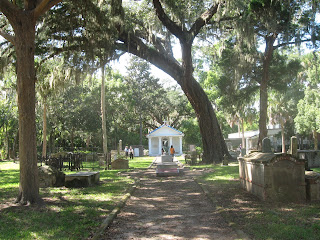Dig It!: Tolomato Cemetery
One of my favorite places to visit in St. Augustine is a cemetery on Cordova Street, usually closed off to the public, surrounded by a barbed wire fence, containing a lovely white mortuary chapel and fascinating burials. I like the Tolomato Cemetery as much for the historical intrigue as for its appearance. When I walk by, I cannot help but admire how beautiful the land is and how the property now uniquely lies in the downtown historic and residential area of St. Augustine. Often explored on ghost tours, Tolomato Cemetery offers a visitor much more than a scary story.
Though the cemetery has been closed to burials since 1892, the cemetery's history begins well before the 19th century. Guale Indians who relocated from Georgia originally inhabited the site during the First Spanish Period (1565-1763). A larger area functioned as a Franciscan mission with a cemetery included. Throughout the years, burials stopped and resumed due to changes in governing powers. Today, more than 1,000 marked and unmarked burials are present in the cemetery.
A new organization, the Tolomato Cemetery Preservation Association (TCPA), formulated by Matthew Kear in his master's thesis, emerged to maintain the property, to protect and preserve the cemetery and open the gates to visitors. When I attended my first meeting, the TCPA permitted us to explore the fascinating cemetery.
I was ecstatic to view the chapel up close AND be able to go inside. Wandering around the grounds, I could finally read the headstones and admire the beauty of the old wording, the intricacies and decoration of each memorial to the past. I could speculate about these people and attempt to imagine who they were and what there lives were like. My visit encouraged me to imagine while giving me a concrete concept of the cemetery. It was certainly worth visiting.
 Now I have been where a mission once stood. I've paid homage to St. Augustine's past. I've seen the commemorations to Bishop Augustin Verot, first Catholic Bishop of St. Augustine, Father Miguel O’Reilly, the first pastor of the Cathedral, General Biassou, hero of Haitian independence, among many others.
Now I have been where a mission once stood. I've paid homage to St. Augustine's past. I've seen the commemorations to Bishop Augustin Verot, first Catholic Bishop of St. Augustine, Father Miguel O’Reilly, the first pastor of the Cathedral, General Biassou, hero of Haitian independence, among many others.

Though the cemetery has been closed to burials since 1892, the cemetery's history begins well before the 19th century. Guale Indians who relocated from Georgia originally inhabited the site during the First Spanish Period (1565-1763). A larger area functioned as a Franciscan mission with a cemetery included. Throughout the years, burials stopped and resumed due to changes in governing powers. Today, more than 1,000 marked and unmarked burials are present in the cemetery.
A new organization, the Tolomato Cemetery Preservation Association (TCPA), formulated by Matthew Kear in his master's thesis, emerged to maintain the property, to protect and preserve the cemetery and open the gates to visitors. When I attended my first meeting, the TCPA permitted us to explore the fascinating cemetery.
I was ecstatic to view the chapel up close AND be able to go inside. Wandering around the grounds, I could finally read the headstones and admire the beauty of the old wording, the intricacies and decoration of each memorial to the past. I could speculate about these people and attempt to imagine who they were and what there lives were like. My visit encouraged me to imagine while giving me a concrete concept of the cemetery. It was certainly worth visiting.


The Tolomato Cemetery attests to St. Augustine's unique, long, and wonderful history.
You can learn more about the Tolomato Cemetery and the TCPA by visiting http://www.tolomatocemetery.com/.
If you'd like to learn more about the Menorcan culture, visit http://menorcansociety.net/.



